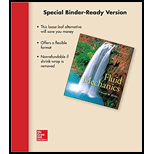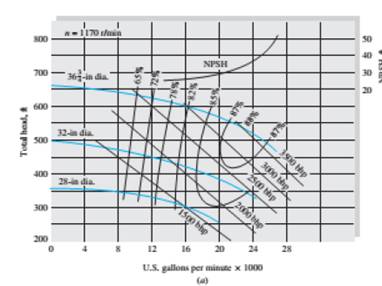
Concept explainers
(a)
The discharge and brake horsepower required for one pump.
Answer to Problem 11.74P
The discharge required for one pump is
Explanation of Solution
Given Information:
Pump diameter, d = 32in

Fig 11.7a
From the figure, the best curve for 32-inch diameter:
Here, a & b = constants
From the curve find constants by taking 2 points
1st point:
Let,
2nd point,
Let,
Now, substitute,
Suction head = Pump head for single pump. So,
We know,
Substituting these values, we get,
Brake horsepower is given by:
Substituting,
We get,
Conclusion:
The discharge required for one pump is
(b)
The discharge and brake horsepower required for two pumps in parallel.
Answer to Problem 11.74P
The discharge required for two pumps in parallel is
Explanation of Solution
Given Information:
Pump diameter, d = 32 inch

Fig 11.7a
For two pumps in parallel, flow rate is half. Hence:
Substitute,
Brake horsepower is given by:
Substitute,
Conclusion:
The discharge required for two pumps in parallel is
(c)
The discharge and brake horsepower required for two pumps in series.
Answer to Problem 11.74P
The discharge required for two pumps in series is
Explanation of Solution
Given Information:
Pump diameter, d = 32in

Fig 11.7a
For two pumps in series, flow rate is two times the actual. Hence:
Substitute,
Brake horse power is given by:
Substitute,
The configuration with 2 pumps in series is the best since, it has the best efficiency.
Conclusion:
The discharge required for two pumps in series is
Want to see more full solutions like this?
Chapter 11 Solutions
Loose Leaf For Fluid Mechanics
 Elements Of ElectromagneticsMechanical EngineeringISBN:9780190698614Author:Sadiku, Matthew N. O.Publisher:Oxford University Press
Elements Of ElectromagneticsMechanical EngineeringISBN:9780190698614Author:Sadiku, Matthew N. O.Publisher:Oxford University Press Mechanics of Materials (10th Edition)Mechanical EngineeringISBN:9780134319650Author:Russell C. HibbelerPublisher:PEARSON
Mechanics of Materials (10th Edition)Mechanical EngineeringISBN:9780134319650Author:Russell C. HibbelerPublisher:PEARSON Thermodynamics: An Engineering ApproachMechanical EngineeringISBN:9781259822674Author:Yunus A. Cengel Dr., Michael A. BolesPublisher:McGraw-Hill Education
Thermodynamics: An Engineering ApproachMechanical EngineeringISBN:9781259822674Author:Yunus A. Cengel Dr., Michael A. BolesPublisher:McGraw-Hill Education Control Systems EngineeringMechanical EngineeringISBN:9781118170519Author:Norman S. NisePublisher:WILEY
Control Systems EngineeringMechanical EngineeringISBN:9781118170519Author:Norman S. NisePublisher:WILEY Mechanics of Materials (MindTap Course List)Mechanical EngineeringISBN:9781337093347Author:Barry J. Goodno, James M. GerePublisher:Cengage Learning
Mechanics of Materials (MindTap Course List)Mechanical EngineeringISBN:9781337093347Author:Barry J. Goodno, James M. GerePublisher:Cengage Learning Engineering Mechanics: StaticsMechanical EngineeringISBN:9781118807330Author:James L. Meriam, L. G. Kraige, J. N. BoltonPublisher:WILEY
Engineering Mechanics: StaticsMechanical EngineeringISBN:9781118807330Author:James L. Meriam, L. G. Kraige, J. N. BoltonPublisher:WILEY





